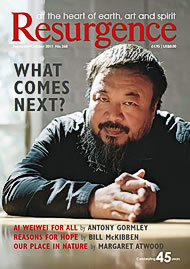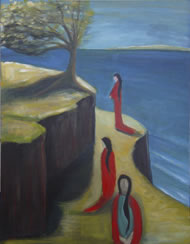Pilgrimage is a universal human phenomenon, an archetype of human existence. A religious custom of ancient origins, it has also become a widespread modern practice that takes place in both religious and secular settings.
Traditionally the word ‘pilgrim’ meant ‘wanderer in distant lands’, someone leaving familiar surroundings behind to seek a distant goal. Such a goal may be far away in spatial terms, but it also offers unexpected discoveries, even of something altogether transcendent; it may lead to inner transformation and healing, to seeing the world in a new light and feeling connected with the spirit of all living things.
To undertake such a journey involves much uncertainty, risk and questing. Will there be a safe return? What efforts are required, what costs incurred?
Pilgrimage centres now exist all over the world and continue to exert a great magnetic pull, including on many a contemporary tourist. They may owe their appeal to a location in natural surroundings of great beauty such as mountains, forests and sources of living water. Or they may be linked to a holy person, a sacred image or statue or a venerated building. Or they may exist thanks to long-told stories of miracles and healing, of founders of faiths and of their saintly followers.
One of the most famous pilgrimages is probably the hajj: the journey to Mecca that it is a religious duty for Muslims to make once in their adult life and that is an important expression of social and religious unity in Islamic culture.
Ancient Israel has had pilgrimages since the biblical period, linked especially to the prescription that all males must annually “go up” to the temple in Jerusalem during the three festivals of Passover, Pentecost and Tabernacles. Jews also know of pilgrimages to the tombs of Talmudic scholars and Kabbalistic sages, and, in modern times, to the holy sites connected with sages of the diaspora outside Israel.
Christians began early to go on pilgrimage to the places where Jesus had lived and died, often referred to as the Holy Land; they also undertook pilgrimages to the tombs of the apostles Peter and Paul in Rome, or to those of the early martyrs. Today, Christian pilgrimage places are found worldwide wherever Christianity has taken root.
In South and South East Asia there are countless pilgrimage sites connected with stupas, temples, pagodas and shrines that mark traces left by the Buddha. Japan has many pilgrimage sites connected with both Shinto and Buddhism, whereas pilgrimages in China relate to Daoism and Buddhism. After the arrival of Communism, many Chinese temples and shrines were destroyed – especially during the Cultural Revolution – so many of those earlier pilgrimages and destinations disappeared, to be replaced eventually by pilgrimages to Mao’s tomb. In recent years many of those traditional sites have been restored, a development I witnessed for myself in 2008 when I visited the Cave of a Thousand Buddhas in Shandong Province and saw countless other visitors all flocking to the restored birthplace, tomb and temple of Confucius.
One of the central pilgrimage places in Tibet is the city of Lhasa itself, the “place of gods” with its famous Jokhang Temple. One has to experience the intense devotion and multiple prostrations of Tibetan pilgrims from far and wide to understand the power of this pilgrimage. Tibet also contains one of the sacred sites of Hindu pilgrimage, the revered mountain of Kailash.
Perhaps no other religious tradition has as many pilgrimage sites as Hinduism, from the sacred “Kashi” (now called Varanasi) and the field of Kurukshetra, connected with the famous Mahabharata epic and with Krishna, to countless sites of gods and goddesses, as well as to sacred mountains and rivers related to many myths about Shiva, Vishnu or the Great Goddess. And the immense pilgrimage of the Kumbh Mela, held every 12 years at the confluence of three rivers near Allahabad, is said to be the largest religious gathering and pilgrimage fair in the world.
But what is the meaning of all this pilgrimage activity, especially in the modern age?
Modern pilgrims, of course, now travel by car and plane to well-known pilgrimage centres that continue to preach their traditional message whilst also using modern means of communication through their own websites, newspapers, bulletins and pamphlets. Religious places of pilgrimage abound, but there are also secular and political pilgrimages linked to personality cults and modern hero worship. For example, pilgrims visit Marx’s tomb in Highgate Cemetery in London; others make a beeline for Graceland, the former home of Elvis Presley, or to localities associated with famous movie stars.
The rise of modern nationalism has added some new dimensions to pilgrimage, evident in the Muslim Hajj¸ in Marian pilgrimages in Poland, and in pilgrimage centres elsewhere. Modern mass transportation, especially cheap air travel, has made pilgrimages to ancient sacred places affordable for vastly larger numbers of people. And the ancient experience of adventure, deprivation and hospitality has been replaced in large part by faster and safer passages for a growing number of pilgrims. Moreover, the benefit of media coverage on pilgrimages such as the Hajj, the Kumbh Mela or a Catholic pilgrimage to Rome or Lourdes means that an audio and visual experience of pilgrimage rites is available to ever more people.
Clearly, embarking on a pilgrimage across the world will present the opportunity to become immersed in an extraordinarily rich material culture in terms of buildings, clothes, ritual and devotional objects, music, dance, prayers, paintings, foods, gifts and souvenirs. But what deeper meaning can be discerned by perceiving pilgrimage as a spiritual metaphor?
The idea of pilgrims as wayfarers in the world, always on the move towards their true goal, can make the whole of human life seem like a pilgrimage, an ongoing journey from life’s beginning to its end.
Always important is the movement of the journey, with its potential for change and transformation embedded in the psychological dynamic of healing, growth and renewal.
Traditionally, the pilgrimage journey is marked by the awareness of a temporary release from social ties, and a preference for simplicity of clothing and food habits, so that fasting and asceticism are often marked features. Then there is a strong sense of fellowship in company with other pilgrims, and the shared experience of moving towards the same goal.
This traditional ‘other-worldly’ and even ‘world-rejecting’ attitude will not resonate with most people living in a largely secular world. Yet I think we can retain two important insights: first, the whole of our life can be understood as a form of pilgrimage, and we can give this journey shape and meaning of great depth and commitment; second, the idea of pilgrimage can also serve as a metaphor of faith – of all human faith and primal trust, without which humans cannot live – as well as the way in which we embody and express the insights of a particular religious faith.
Dante’s journey in The Divine Comedy through the medieval worlds of hell, purgatory and heaven is a cosmic and deeply religious pilgrimage that is ultimately motivated, sustained and fulfilled by the tremendous vision of love. It is this powerful attraction that undergirds all fascination with the spirit of pilgrimage, even in an age of modernity.
Let us be modern pilgrims – pilgrims in new ways, with new visions and with a thirst for new discoveries and adventures – but also true Earth pilgrims who seek communion with the Earth and all its peoples and experience the interconnectedness between all living beings in an all-embracing spirit of love.








